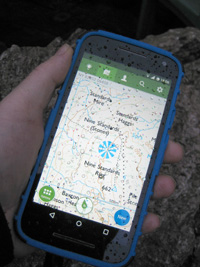General info > GPS > Motorola Moto G
Motorola 'waterproof' phone
 When Motorola announced that its latest budget smartphone, the Moto G 3rd Generation phone, was water resistent (to IPX7 standard), we couldn't resist giving it a go. Priced at around £160 for an unlocked version – we got ours from John Lewis - it could be a decent option for outdoor use as a phone-cum-GPS, providing of course that it does the job.
When Motorola announced that its latest budget smartphone, the Moto G 3rd Generation phone, was water resistent (to IPX7 standard), we couldn't resist giving it a go. Priced at around £160 for an unlocked version – we got ours from John Lewis - it could be a decent option for outdoor use as a phone-cum-GPS, providing of course that it does the job.
So what's it like? Well as a standard smartphone running an unadulterated version of Android it's absolutely fine. It's not particularly dinky but the 5 inch screen size is a bonus for browsing the internet, reading emails and of course for viewing mapping. With a mapping app like ViewRanger or Memory-Map you can see a decent amount of mapping on the screen, even when zoomed right in. The screen is nice and bright, even in direct sunlight, and it's good to know that it's made out of the robust 'Gorilla Glass'. We've found that the GPS finds its location pretty quickly and that accuracy is good. Battery life is also decent with a 2470 mAh battery, although as with any phone being used in the outdoors it's best to carry a recharging pack, especially if you are using it for navigation.
You would probably want to get a protective case for outdoor use. We got a bright blue one for around £12 from MobileFun which provides a better grip on the phone and might protect it a bit if you dropped it. More expensive cases from the likes of Otterbox are available, for around three times the price. You would almost certainly want to be beef up the storage with a microSD card of 16GB or 32GB. We bought the latter which is more than enough for OS 1:50,000 and 1:25,000 mapping for the whole of GB, plus some room for photos. Speaking of which, the camera is remarkably good for such an inexpensive phone and could save you carrying a dedicated camera on many outings.
 Any mapping and navigation apps you put on it could be influenced by what you have already bought. If you have a PC version of Memory-Map, for instance, it would make sense to use the Memory-Map app and transfer maps for no extra cost to the phone. ViewRanger works well on the Moto G and of course it links directly with Walkingworld, so if you have a Walkingworld subscription that would make perfect sense. The new OS Maps app also provides mapping downloads to the phone if you have a subscription to the service, but you have to make a special effort to save the map to the phone for offline use - if you are very organised this could be a low cost solution.
Any mapping and navigation apps you put on it could be influenced by what you have already bought. If you have a PC version of Memory-Map, for instance, it would make sense to use the Memory-Map app and transfer maps for no extra cost to the phone. ViewRanger works well on the Moto G and of course it links directly with Walkingworld, so if you have a Walkingworld subscription that would make perfect sense. The new OS Maps app also provides mapping downloads to the phone if you have a subscription to the service, but you have to make a special effort to save the map to the phone for offline use - if you are very organised this could be a low cost solution.
There are also some simple and free apps that can help with standard navigation using a map. OS Locate is a neat little app that displays a six-figure grid reference - it even allows you to share it via a text to someone else. If you want to see a 10 figure reference we like the 'GPS Test' app from Chartcross, which displays a reference in multiple formats and shows the satellites being received by the phone with an estimate of accuracy.
All in all it's good to see phones coming onto the market that reflect the way that quite a lot of people actually use them, out in the real world where they sometimes get wet. The Moto G is a good start, although it's clearly not as rugged as Memory Map's TX4. Perhaps before too long we'll see reasonably priced smartphones that are not just waterproof but also rugged and easy enough to hold in the hand without having to put them in a special case. All in all, though, this is a good phone, it'll survive a dunking and you really can't complain about the price.